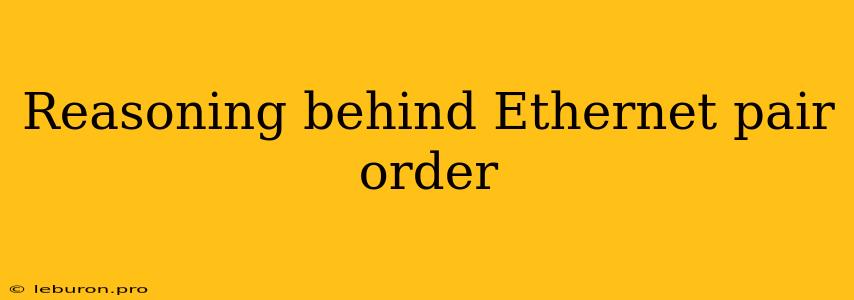The proper Ethernet pair order is crucial for optimal network performance. It ensures that signals travel efficiently and minimize interference, resulting in faster data transmission and reliable connectivity. Understanding the reasoning behind Ethernet pair order involves delving into the principles of twisted-pair cabling and the inherent challenges of signal transmission.
Understanding Twisted-Pair Cabling
At the heart of Ethernet pair order lies the concept of twisted-pair cabling. This type of cable consists of two insulated wires twisted together, forming a pair. This twisting is not arbitrary; it serves a specific purpose. The primary reason for twisting is to reduce electromagnetic interference (EMI). When current flows through a wire, it generates a magnetic field. If wires are parallel, these magnetic fields can interact and cause interference, leading to signal degradation and data errors.
Twisting the wires effectively cancels out the magnetic fields, as the direction of the twist alternates. This cancellation effect is most effective when the pairs are twisted at a specific frequency, which is determined by the cable's specifications. The tighter the twist, the higher the frequency at which interference is minimized.
The Importance of Pair Order
While the twisting of the wires is essential, the order in which these pairs are arranged within the cable is equally critical. The Ethernet pair order dictates how the signal travels through the cable and influences the interaction between different pairs. Improper Ethernet pair order can lead to:
- Increased crosstalk: When signals from adjacent pairs interfere with each other, this is called crosstalk. It can cause data corruption and slow down network performance.
- Reduced signal integrity: Incorrect Ethernet pair order can cause signal reflections and attenuation, which weakens the signal strength and impacts data transmission.
- Compliance issues: Many networking standards, such as TIA/EIA-568, specify the correct Ethernet pair order. Adherence to these standards ensures compatibility and proper network operation.
Common Ethernet Pair Order Standards
There are two main standards for Ethernet pair order:
- TIA/EIA-568
- ISO/IEC 11801
TIA/EIA-568 is the standard commonly used in North America, while ISO/IEC 11801 is widely adopted in Europe. Both standards specify two variations for Ethernet pair order: T568A and T568B.
T568A and T568B
The primary difference between T568A and T568B lies in the order of the wires within the cable. The following table illustrates this difference:
| Pair | T568A | T568B |
|---|---|---|
| Pair 1 (Blue) | White-Blue, Blue | White-Orange, Orange |
| Pair 2 (Orange) | White-Orange, Orange | White-Blue, Blue |
| Pair 3 (Green) | White-Green, Green | White-Green, Green |
| Pair 4 (Brown) | White-Brown, Brown | White-Brown, Brown |
T568A and T568B are both valid standards, and the choice of which one to use is typically based on pre-existing infrastructure or specific network requirements. The key takeaway is to use the same standard consistently for both ends of the cable, ensuring proper signal transmission.
Consequences of Incorrect Ethernet Pair Order
When the Ethernet pair order is incorrect, the signal can be disrupted, leading to various problems:
- Reduced network speed: Signals can be distorted or attenuated, resulting in slower data transfer rates.
- Increased latency: The delay in signal transmission can lead to noticeable lag, particularly for real-time applications.
- Data errors: Signal interference can cause corrupted data packets, resulting in data loss and network instability.
- Interoperability issues: Non-compliant cabling can cause compatibility problems with certain network devices.
Verifying and Correcting Ethernet Pair Order
It is crucial to ensure the correct Ethernet pair order throughout the network infrastructure. This can be achieved by:
- Using a cable tester: These specialized tools can verify the Ethernet pair order and identify any wiring errors.
- Inspecting the cable: While not as precise as a tester, visual inspection can often identify obvious wiring inconsistencies.
- Consulting the wiring diagrams: Referring to the appropriate standards and documentation can confirm the correct Ethernet pair order.
If wiring errors are detected, it is necessary to rewire the cable to correct the Ethernet pair order. This may involve re-terminating the cable or completely replacing it, depending on the severity of the error.
Conclusion
The Ethernet pair order is a fundamental aspect of network cabling that directly impacts performance and reliability. Understanding the reasoning behind Ethernet pair order is essential for ensuring efficient and stable network operation. By adhering to the correct standards and using appropriate tools to verify the Ethernet pair order, network administrators can minimize interference, improve data transmission speed, and enhance overall network performance. Proper wiring practices, including the correct Ethernet pair order, are essential for building robust and reliable network infrastructure.
